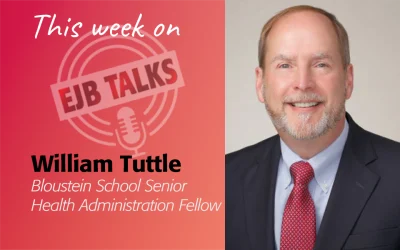Exploring Healthcare Challenges: Medical Debt and Provider Burnout
Dean Stuart Shapiro hosts health administration Associate Professor Irina Grafova on EJB Talks this week, discussing her transition from labor economics to health economics and her research focusing on medical debt and provider burnout. She explains how medical conditions can impact family situations, often leading to medical debt due to high out-of-pocket costs and reduced income from productivity loss. Grafova suggests potential solutions like financial navigation programs and revising income support policies for long-term disability. She also highlights her research on nurse burnout, emphasizing the need for evidence-based interventions to address workforce management and retention strategies. They conclude with a conversation on the interdisciplinary nature of health administration students and the importance of their diverse experiences in her teaching.
Read transcript:
Stuart Shapiro
Welcome to EJB Talks. I’m Stuart Shapiro, the dean of the Bloustein School, and the purpose of this podcast is to highlight the work my colleagues and our alumni in the fields of policy, planning, and health are doing to make the world a better place.
We’re going to speak today with a relatively new faculty member in our Health Administration program, Professor Irina Grafova. Irina works on such varied topics as provider burnout and medical debt. Welcome to the podcast Irina!
Irina Grafova
Thank you for having me, Stuart!
Stuart Shapiro
So long-time listeners know I always start with a, pretty much the same question, at least with first-time guests. Let’s hear your origin story. How did you become interested in researching issues around healthcare?
Irina Grafova
Well, when I was in graduate school, I actually thought I would become a labor economist. I was interested in the impact of health behaviors on labor market outcomes. And as I was doing more work in this area, my interest in health economics began to grow. What I did not realize at the time was that I was mirroring the origin story of health economics itself, which evolved from labor economics.
Stuart Shapiro
And so that got you to, and you decided just to go whole hog into health at that point?
Irina Grafova
It was a gradual process, yes, but this is what got me involved. I worked with some great people who worked in the area of both labor and health economics, and so they got me interested.
Stuart Shapiro
And you seem to still be very interested in how healthcare interacts with other aspects of people’s lives, right?
Irina Grafova
That’s correct.
Stuart Shapiro
Yeah, well, one of those aspects of people’s lives is medical debt and debt in general. Can you tell us how you became interested in that subject?
Irina Grafova
Well, you know, this probably originates, actually, even to my early research on, like I mentioned, on health behaviors. Because one of the things I’ve been finding in the earlier research is that health behaviors are related not only to labor market outcomes such as wages, but they also relate to some of them, family financial indicators, including indebtedness. So I became, then, interested in general, how health is related to family finances. How they are linked, and thinking about those linkages and realizing that this is a two-way street. That on the one hand, you can have adverse economic shocks affecting health, for instance, because adverse economic shocks may mean that family would need, say, to cut in the healthcare spending, which would initially adversely impact their health status. But it’s also possible that adverse health shocks would be affecting the family finances, because they, for example, need to finance their care. And so sometimes that happens in the form of debt financing.
Stuart Shapiro
Gotcha, gotcha. And so people, there’s this interaction between medical debt and credit card debt that you’ve talked about. Tell me a little bit about that and how it can really be crippling for people.
Irina Grafova
Well, I think I probably need, maybe to start by talking about why disease can lead to different kinds of debt. And why people go into debt when they, when they get sick. And there are a few reasons for that. One of it is, that disease often comes with sizable medical out-of-pocket costs, even for those who have health insurance. So those out-of-pocket costs have to be paid, and people don’t necessarily have the income or the assets to pay for those costs.
But at the same time, when you get sick with some of those diseases, it comes with productivity loss. For instance, because of the functional limitations onset, and that productivity loss may result in the lower earnings for you. Or actually, it could be that somebody in your family has to take care of you, and then they also cannot work as much. So on the one hand, when you get sick, on the one hand, you have higher medical out-of-pocket spending, but on the other hand, you have lower income inflow. And so this puts families experiencing adverse health shocks between a rock and a hard place. And so then they try to finance those spendings so they can go into medical debt. Maybe they don’t pay their medical bills, or they have to pay it in an installment, or not at all. Or they put it on a credit card, on a regular one, or a medical credit card. But sometimes they also have to adjust their lifestyle. Maybe it’s a new diet. Maybe they have to make some kind of alterations, adjustments to the home. So that means that they may need to go to the other forms of debts, whether it’s a credit card, to some of the other forms.
Stuart Shapiro
Yeah, preventative measures like you mentioned, a better diet, they tend to be more expensive.
Irina Grafova
Yes, yes, yes. They have to… if it’s a healthier diet that now they have to adhere to, it would be more expensive. If they now, they will turn to say, eating more fresh fruits and vegetables, they tend to be more expensive than the processed food,
Stuart Shapiro
Right, right. And like you mentioned, the other accommodations you might have to make to your home or anything else also means more money that you spend. At the same time that less money might be coming in. It’s a basic inflow-outflow problem. A basic budget problem for people who are very income constrained, perhaps to start out with.
Irina Grafova
I think one of the issues here is that, why people go into debt, is because of so much of the family’s budget is spoken for. There is this big consumption commitment. You are committed to spending, as part of your income inflow, on the mortgage. You have to pay your car insurance, the gas and other things. And so there is actually relatively little for a lot of families left with, that they can somehow adjust in this kind of situation. And so a lot of them have to resort to debt.
Stuart Shapiro
Yeah, so I’m a public policy person at hard and I don’t know that government or policy is the answer here. Maybe it’s answers within the healthcare system. But what can we do about this? Are there solutions out there to alleviate this problem of medical debt that, at the same time, leads to greater expenses or perhaps lower income in other areas?
Irina Grafova
Well, it’s a… it’s not an easy question to answer, because there are obviously some bandaid solutions. And then there are some solutions that potentially can address the root cause of the problem. The solutions that would address the root cause of the problem, they are much more challenging because they require, for instance, to address the issue of the high medical costs. And this is a fundamental thing, and very, very hard to address. But there are certainly, even within the current system and within the current cost system, there are some of the banded, if you like, solutions that we can try.
And one of those solutions could be wider proliferation of the financial navigation programs. These are the programs that very often, we can commonly find in, for instance, oncology care settings. And they can help patients with a number of things, including a choice of health insurance. There are a lot of people who don’t have the health insurance who best fits, actually, their needs, and they can pick a different one at their job or within the Medicare system that actually will pay better for what they need.
Stuart Shapiro
So I like bandaids because the wholesale solutions will take time. And bandaids are always a step on the way to the wholesale solution. I would assume, strengthening the social safety net would also presumably help? It’s an income, guaranteed income, or something along those lines, would at least be some help in this area as well.
Irina Grafova
Yes, this is another area, because we have SSI, we have SSDI. But you know, our income support policies, especially targeting people with disabilities, they had been created a long time ago, and they had been created, I’d say, with a slightly different view of disability. They’ve been created more with the view of these people are disabled and they’re going to die soon. What has been happening, for instance, with cancer care, is that we learned to treat cancer much better. People live with cancer much better than they used to. Mortality rates are down. There is a greater survivorship. But that comes at a cost. The cost would be long-term functional limitations. And our income support policies targeting people with disabilities, they have not been designed with this in mind. So actually revising some of those income support policies, I think, would be really helpful to a lot of people who have experienced financial burden of the disease and functional limitations because of those diseases.
Stuart Shapiro
Yeah, as our ability to prolong people’s lives under medical conditions improved, we’ve actually exacerbated this debt problem, if you will. Because…and it’s a good thing that we people live longer, right? We want that to happen. We want them to be able to enjoy life and children and grandchildren, etc. But we can’t just do that and ignore the financial implications there. Before we we move away from your research. I do want to let you touch on the new work you’re doing on provider burnout. Tell me about what you’re looking at there.
Irina Grafova
Okay, so this is the area of work that, kind of grew out of my interest on to multidimensionality of the socioeconomic status and health. Because I used to do some of the work on the effect of the environmental health, mostly focusing on built and social environment. And this body of work grew during Covid-19, when basically the work environment changed so much, especially for the healthcare provider. So I collaborated with a great colleague of mine, Dr de Cordova, from the (Rutgers) School of Nursing, and we did the project during the Covid pandemic that focused on acute care nurses stress and burnout during what ended up being the end of the first wave, and the beginning of the second wave of the Covid-19.
And so this is what kind of got me interested in this area of the research. And what I realized is that providers, particularly nurses, experience a lot of pressure, a lot of both physical and emotional burnout, and that this is a big problem in the healthcare system, because of the turnover, because of the quality of care implications, and so on. And the healthcare system is trying to address this. But I think there are, there is a lack of evidence-based approaches on how best to address the nurse burnout. And this is what I am interested in. To see what kind of approaches are working. Should they be employment based, not employment based, how best potentially to roll out some of those interventions, so that they are accessible and that there is an equity in access to them. So I’m interested broadly in the provider burnout issues and how well the system is prepared for those issues and what the healthcare system can do to help alleviate it.
Stuart Shapiro
I’m excited to see where this research, goes, and it’s a great fit with your moving into our Health Administration program. Can you talk a little bit about how your research informs your teaching as you’ve come over to become a Health Administration professor?
Irina Grafova
Yeah so let me give an example of the nurse burnout research. A lot of the MHA graduates want to go and work in the hospitals, and nursing is one of the biggest expenses, actually, for the hospitals. You know the nursing industry, they experienced the shortages and the burnouts and the turnover prior to the Covid pandemic, but pandemic definitely exacerbated those issues. So talking to the students in health administration about those issues, I think is very important. Because I can highlight to them the importance of the workforce management. I can help them to understand the factors that are contributing to the nurse door numbers, so that students appreciate the complexity of the staff retention strategies that help to prepare them to implement some of those solutions when they become the future health administration leaders. I think it is important that they learn about the importance of evidence-based practices to reduce the burnout and the turnover.
Stuart Shapiro
That’s great. Well, let me wrap up with a teaching question and about your transition here. What surprised you about teaching health administration?
Irina Grafova
(laughing) You know, I think it has been the interdisciplinary nature of the student body. I come from public health, and I know that in public health, the student body is very interdisciplinary, comes from different backgrounds, like to the graduate school. But I didn’t realize that they would be a diversity, actually, of experiences in the health administration student body, and in their backgrounds. They really come with very diverse set of interests and the backgrounds, and it’s it’s exciting to teach them, and actually to learn fom them. Because a lot of them have real work experience and having the classroom where they, I think, enrich each other with their experiences and enrich me, and then I share something with them. I think it’s a great privilege.
Stuart Shapiro
That’s great. Well, we are happy to have you, that’s for sure. Thank you so much for coming on the podcast.
Irina Grafova
Thank you for having me.
Stuart Shapiro
Also a big thank you, of course, to Tamara Swedberg and to Karyn Olsen, who help make this podcast happen. We’ll see you next week with another talk from another expert from the Blaustein school. Until then, stay safe.




